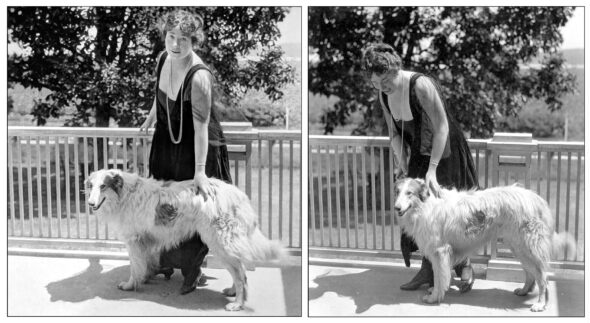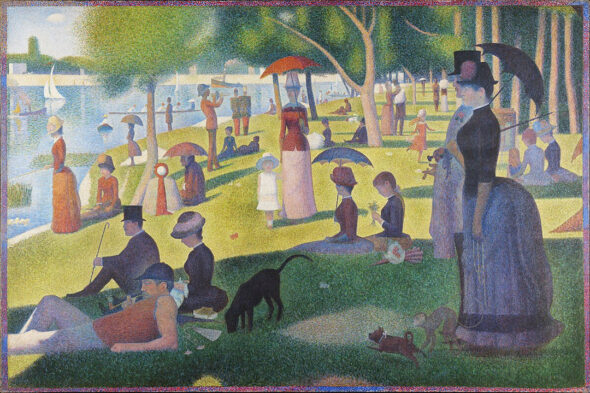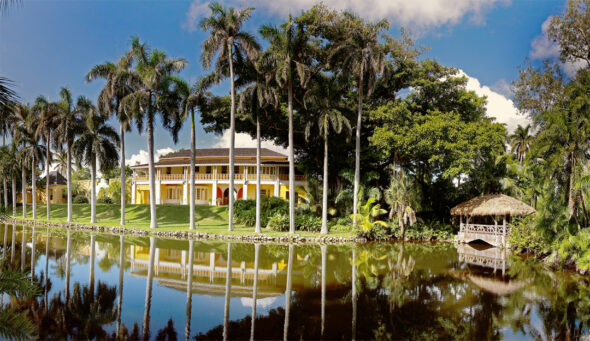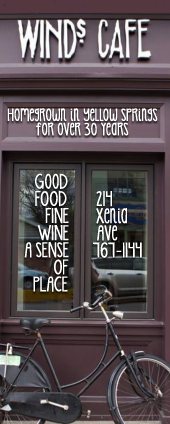
This year marks the 100th anniversary of the death of Helen Birch Bartlett, the namesake of local nature preserve Glen Helen. But as staff and volunteers at both Glen Helen and Bonnet House in Fort Lauderdale, Florida, attest, Helen was more than a namesake — and the two institutions have formed a relationship this year in sharing information and history on Helen’s life, including photos: At left is a photo of Helen that was in the care of Glen Helen for many years; at right, a photo kept by Bonnet House — both of which appear to have been taken at the same time, but separated until this year. (Submitted photos)
Celebrating Helen Birch Bartlett and a shared history
- Published: August 5, 2025
Helen Birch Bartlett’s name is carved in limestone at the entrance to Glen Helen Nature Preserve. Most folks in Yellow Springs know her as the daughter of Hugh Taylor Birch, who gave the land that became Glen Helen in her name after her untimely death at the age of 42.
But beyond being the namesake for the Glen, who was Helen Birch Bartlett?
This year marks the 100th anniversary of Helen’s death. In her lifetime, she was a writer, musician, collector and tastemaker. By all accounts, she had an eye for beauty and a devotion to the arts that can still be felt a century later, if you know where to look.
That’s what two institutions — Glen Helen in Yellow Springs and Bonnet House Museum and Gardens in Fort Lauderdale, Florida — hope to bring to light this year in celebrating Helen’s life and memorializing her death. At the same time, the two institutions have formed a new relationship built on shared information.
Helen, ‘influencer’ and artist
In speaking with the News in late June, former Glen Helen Association board member Bill Kent said Helen Birch Bartlett’s considerable legacy may come as a surprise to some folks.
“I’ve taken a personal survey and asked dozens of people,” Kent said. “I’d say one out of 20 at the most have had any idea that [Helen] was connected to art in any way.”
But in fact, he said, we may owe our familiarity with some of Europe’s most well-known and celebrated modern visual artists to Helen and her husband, American painter and muralist Frederic Clay Bartlett: In the years between 1919 and 1925, Helen and Frederic were amassing what would become one of the most significant modern art collections in the U.S.

“A Sunday Afternoon on the Island of La Grande Jatte” by Georges Seurat
In 1923, the Chicago couple acquired Matisse’s “Woman Before an Aquarium.” The following year, they purchased Seurat’s “Sunday Afternoon on the Island of La Grande Jatte.” Picasso’s “The Old Guitarist,” which they also acquired, is often cited as the first Picasso ever placed on permanent display in an American museum. They also added works by Gauguin and Van Gogh to their collection.
“They were acquiring artists whose names are now known and celebrated,” Glen Helen Director Nick Boutis said. “But … these artists were not known and celebrated in the United States [at the time]. I suppose it’s somewhat difficult to know how much their acquisitions created the public appetite … but quite clearly, they’re in the mix in terms of the reason that you’re able to look at ‘A Sunday Afternoon on the Island of La Grande Jatte.’”
“In a sense, the modern word for what she was, in terms of [the American art scene], is an influencer,” Kent added.
In 1926, the year after Helen’s death, her husband donated their entire collection to the Art Institute of Chicago, where Frederic had been a trustee and to which the couple were devoted.
“This stuff was never meant to go in their home,” Kent said. “All the stuff went into what is now known as the Helen Birch Bartlett Memorial Collection.”
Though she was dedicated to appreciating the arts as a collector and benefactor — she was a supporter of the Chicago Symphony Orchestra and a fixture in the city’s music circles — Helen was herself an artist. She wrote and published original poetry and composed music, sometimes setting the works of other poets to her own tunes. Original copies of some of her published scores are housed at the Newberry Library in Chicago — and reproduced copies are in the possession of Glen Helen.
Her poems, written in free verse, were often meditations on nature, joy, beauty and death. As Helen wrote in an early poem, Sanctuary:
White water rippling.
There is a veil between us
Hangs like centuries of time.
And all that has been
Dissolves into the motes of gold
That move in the pathway of the sun.
The gates swing slowly open.
In 1927, two years after her death, a collection of Helen’s poems was published as “Capricious Winds.” Her friend Harriet Monroe, who was editor of Poetry magazine, wrote in a foreword to the book that Helen’s poetry “corresponded with her own intense vitality and profound love of life.” Monroe also noted that Helen submitted her work to Poetry magazine under a pseudonym, only revealing herself as author when her poems were selected for publication, “lest a friendly prejudice should overvalue them.”
“Capricious Winds” has been out of print for decades. However, as part of the recognition of Helen’s life and passing, Kent, Boutis, local resident Eric Johnson and others worked to republish “Capricious Winds” from an original copy of the book, which is now available in paperback in the Glen’s Nature Store.
Also part of the 100th anniversary of Helen’s death has been bringing some of her music back to life: In January, using copies of her original sheet music, three of Helen’s songs were recorded in the Foundry Theater: “The Moods,” “Aedh Laments the Loss of Love” and “Requiescat.” The recordings feature Sarvani Nicolosi, soprano with World House Choir, accompanied on piano by Tucki Bailey; the recordings were engineered by Chris Westhoff.
Kent said the efforts to catalogue and reintroduce Helen’s original work to the public are meant as a tribute to a person whose legacy is more than just the name we all remember when we hike to the Yellow Spring.
“[Helen] gets kind of lost in the shuffle of history in Yellow Springs, because it’s so heavily weighted toward her father,” he said. “But she was probably, historically, much more important.”
Sharing Helen’s history
Nearly 1,200 miles from Yellow Springs, under sunny Florida skies, memories of Helen Birch Bartlett are kept by another institution that, like Glen Helen, offers visitors a verdant retreat, as it did for its inhabitants.
In 1919, Hugh Taylor Birch — who had spent years acquiring hundreds of acres of land in Florida — gave Helen and Frederic 35 acres of land in what is now metropolitan Fort Lauderdale as a wedding gift. The couple began building the shared coastal home that would be known as Bonnet House in 1920.
Katie Valli, who serves as curator at Bonnet House, now open to the public as a museum and botanical garden, told the News in July that the Florida home was meant to be a retreat for the Bartletts — a “kind of respite for them to come down and be creative.”
“[Frederic] built a studio for himself … and Helen was a composer and published poet, so she actually has a music room down here that was dedicated to her and specifically for her to create music,” Valli said.

Bonnet House Museum & Gardens. (Photo: bonnethouse.org)
Bonnet House features both curiosities of architecture — it borrows from Caribbean traditions, with an open courtyard, but also sports an arched tower and walls reinforced with rebar — and artistic works, including Frederic Clay Bartlett’s own paintings. Valli said that the nature of the property, surrounded by trees and walls, is often hidden from outside view.
“It’s an extremely metropolitan area with lots of businesses, high rises and beach culture — and then you step on the property, and it’s like going back in time,” she said.
In 1925, only five years after construction began, Helen died of breast cancer. After her death, Frederic didn’t resume regular visits until 1931, when he remarried. Helen’s father would dedicate Glen Helen to her memory in 1929, and remained a frequent resident of Bonnet House, where he had his own room.
Hugh Taylor Birch is sometimes cited as a “grandfather of Fort Lauderdale,” Valli said, because of his influence on the landscape of the city, even today. Just across the street from Bonnet House, in fact, is the 180-acre Hugh Taylor Birch State Park, known as the city’s own “Central Park.”
“He was very specific in saying that he wanted [the land] to remain a park and to not be developed, because we are really, really developed down here,” Valli said.
Like those in Yellow Springs who have been working to shore up public knowledge of Helen Birch Bartlett’s life and work, Valli said those at Bonnet House, too, noted that this year marks 100 years since her passing. She said she was considering how to memorialize Helen’s life when Yellow Springs resident Eric Johnson happened to visit Bonnet House, and began making introductions between the museum and the village’s nature preserve.
“It was something that I wanted to do, but it wasn’t really at the forefront — until [Johnson] and Nick Boutis contacted our CEO, Patrick Chevroski.”
That contact opened the door for a collaboration between the institutions, which began sharing information and, in at least one case so far, even artifacts: This year’s spring issue of In the Glen magazine features a photo of Helen in typical early-20th-century dress, looking into the camera’s lens as she pets a dog.
“We shared the image with [Bonnet House], and they said, ‘Oh, we’ve got a different image from the same roll of film!’” Boutis said. “We were each touching different parts of the elephant.”
“Our photo is just like theirs, but [Helen] is looking down, and I said, ‘I would love to have that photo in our archives,” Valli said. “That’s what really began our exchange of information — we discovered things about Glen Helen, and they discovered things about Bonnet House.”
Bonnet House mounted its own centennial exhibit this July, showcasing Helen’s letters, sheet music and personal items — including her copy of “Capricious Winds” — in her music room. The exhibition, created by Valli and intern Maria Formoso, will be on display for a year.
Valli said she’s glad Eric Johnson came into Bonnet House, starting the ball rolling for a connection between Ohio’s and Florida’s histories with regard to the Birch family that she said she hopes will continue “down the line.”
“It’s been a great experience, and I’m so glad that we created this relationship,” she said.
Glen Helen will continue to celebrate the life of Helen Birch Bartlett this year; a presentation by Bill Kent, with support from the YS Historical Society, is currently in the works for October — the month Helen died — at the Senior Center. More details will be announced in the News and at glenhelen.org in the future.
For more information on Bonnet House, go to http://www.bonnethouse.org.
One Response to “Celebrating Helen Birch Bartlett and a shared history”
The Yellow Springs News encourages respectful discussion of this article.
You must login to post a comment.
Don't have a login? Register for a free YSNews.com account.















Kudos to the YS News for recognizing and celebrating the life of Helen Birch Bartlett. Generations of citizens of Yellow Springs and the greater Miami Valley have benefitted from the natural treasure bequeathed by her family that bears her name. It was my playground as a child and I make an effort to retrace my childhood steps every time I am back in town for more than a few hours.